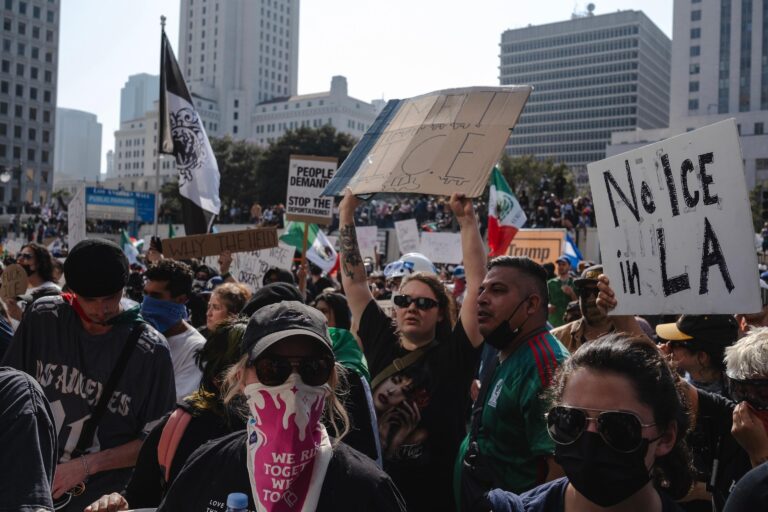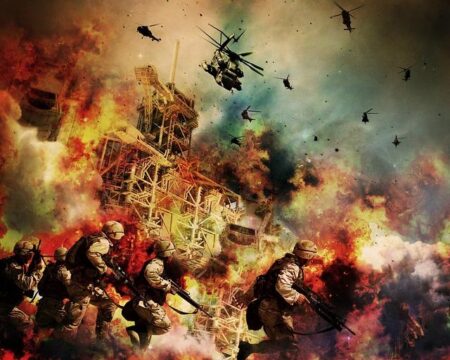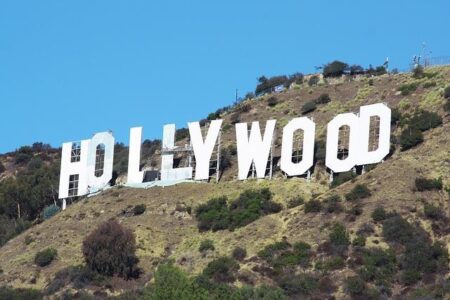Federal Troop Surge in Los Angeles Sparks Debate Over Protest Response and Civil Rights
Heightened Federal Presence Amidst Growing Los Angeles Demonstrations
In response to the ongoing wave of protests across Los Angeles demanding racial justice and police reform, the federal government has intensified its intervention by dispatching over 3,000 additional troops to the city. This escalation, initiated under former President Donald Trump’s administration, has ignited fierce criticism from activists and local leaders who denounce the move as an excessive and authoritarian crackdown on peaceful dissent. Protesters contend that the militarized approach exacerbates existing tensions instead of addressing the systemic issues at the heart of the unrest,such as racial inequality and police misconduct.
Authorities defend the deployment as a necessary measure to safeguard federal properties and restore public order amid large-scale demonstrations. However, community members and civil rights advocates caution that such a forceful presence risks provoking confrontations and undermining constitutional freedoms.Key concerns include:
- Risk of violent encounters: The augmented troop numbers may increase the likelihood of clashes between law enforcement and demonstrators.
- Suppression of peaceful protest: Enhanced surveillance and detentions raise fears about curtailing free expression and assembly.
- Strained community relations: The militarization of public spaces threatens to deepen mistrust between residents and authorities.
| Federal Deployment | Protest Scale | Impacted Areas |
|---|---|---|
| 3,000+ troops and 250+ vehicles | Over 12,000 participants | Downtown, Koreatown, South LA, Hollywood |
| Federal agents from multiple agencies | More than 120 organizations involved | Westlake, Echo Park |
Concerns Over Government Overreach and Civil Liberties
Civil rights groups and legal experts have raised alarms about what they describe as an authoritarian shift in federal tactics, warning that the deployment of additional troops risks infringing on essential constitutional protections. The increasing militarization of public spaces is seen as a perilous precedent that could stifle dissent not only in Los Angeles but across the nation. Advocates emphasize the importance of clarity and accountability in managing such operations to prevent abuses of power.
The debate centers on finding a balance between ensuring public safety and safeguarding individual freedoms. Key issues highlighted by watchdog organizations include:
- Excessive governmental control: Potential erosion of rights to free speech and peaceful assembly.
- Insufficient oversight: Lack of independent monitoring of federal troop activities.
- Militarization of civil spaces: The presence of armed forces in civilian areas raises concerns about escalation.
- Community impact: Increased tension and fear among residents, notably marginalized groups.
| Issue | Consequences | Advocate Suggestions |
|---|---|---|
| Troop Deployment | Increased federal presence at protests | Restrict to non-confrontational roles |
| Legal Accountability | Gaps in oversight mechanisms | Establish independent review panels |
| Public Safety | Risk of escalating violence | Focus on community engagement strategies |
Examining the Effects on Community Trust and Policing
The surge in federal troop deployment has intensified scrutiny of the relationship between law enforcement agencies and the communities they serve. Critics argue that the presence of heavily armed personnel in neighborhoods frequently enough transforms public spaces into zones of conflict, undermining efforts to build trust and cooperation. This militarized approach may alienate marginalized populations further, complicating efforts toward community policing and reconciliation.
Scholars and activists alike highlight several critical concerns:
- Potential for violence escalation: Aggressive tactics may provoke unrest rather than quell it.
- Damage to community relations: Militarization can foster fear and resentment among residents.
- Challenges in oversight: The complexity of federal involvement can hinder accountability.
- Long-term psychological effects: The visible show of force may have lasting impacts, especially on youth.
| Factor | Potential Outcome |
|---|---|
| Community Trust | Marked decline due to perceived intimidation |
| Protester Reactions | Varied; some deterred, others radicalized |
| Law Enforcement Efficiency | Short-term control achieved; long-term community strain increased |
Advocating for Open Dialog and Complete Policy Changes
Community leaders, activists, and policymakers are calling for clear and inclusive conversations among government officials, law enforcement, and affected populations to bridge the widening divides exposed by recent protests. They stress that only through sincere dialogue can the systemic roots of inequality and disenfranchisement be effectively addressed. Without such engagement, the deployment of additional troops risks deepening societal fractures rather than fostering reconciliation.
There is a growing demand for targeted reforms aimed at tackling the social inequities underscored by the demonstrations. Priority reform areas include:
- Reforming criminal justice policies to curb excessive use of force by police.
- Expanding access to affordable housing and quality healthcare services.
- Enhancing educational and economic opportunities for historically marginalized communities.
- Strengthening oversight and accountability frameworks for law enforcement agencies.
| Reform Area | Objective | Anticipated Benefit |
|---|---|---|
| Criminal Justice | Reduce incidents of police violence | Lower community tensions and improve safety |
| Housing & Healthcare | Increase affordability and access | Enhance overall quality of life |
| Education & Economic Opportunity | Expand access to resources | Promote social mobility and equity |
| Law Enforcement Oversight | Ensure transparency and accountability | Rebuild public trust in institutions |
Conclusion: Navigating the Complexities of Protest and Public Safety in Los Angeles
As Los Angeles continues to grapple with widespread protests, the federal government’s decision to increase troop deployment represents a pivotal and contentious development in managing civil unrest. While officials argue the necessity of such measures to maintain order, critics warn of the dangers posed by an authoritarian approach that may inflame violence and erode fundamental rights. The unfolding situation in Los Angeles serves as a critical test case for balancing security imperatives with the preservation of democratic freedoms, with national attention focused on how this delicate equilibrium will be maintained moving forward.




